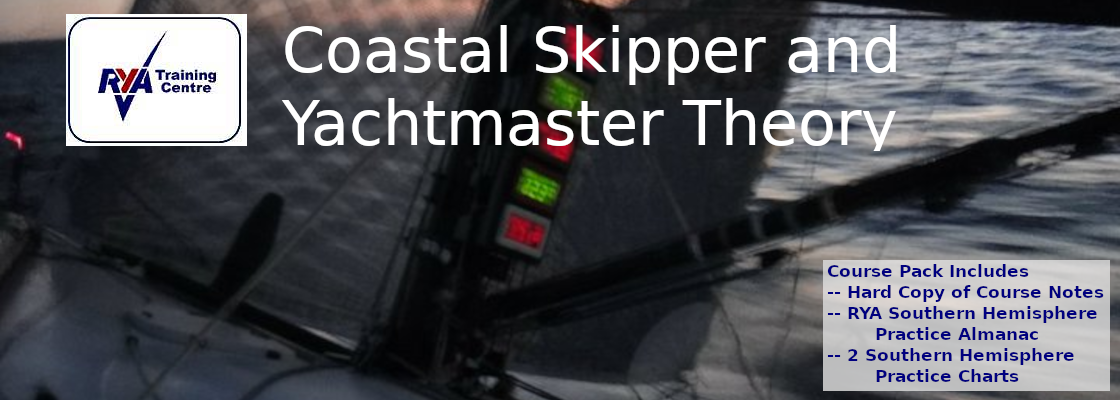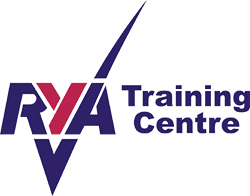
This is an advanced course in coastal navigation and builds on the knowledge gained in Day Skipper. It is more of the same with more complex navigation exercises and some additional subjects. The RYA Coastal Skipper / Yachtmaster Offshore theory course
covers both Coastal Skipper and Yachtmaster Offshore and is the required level of theory for RYA Coastal Skipper or the RYA/MCA Yachtmaster Examinations. The course aims to to take you to an advanced level of knowledge for chart work,
tides, weather and collision regulations and is the peak theory qualification in coastal navigation. The course assumes you have navigation knowledge up to Day Skipper level.
If you are not sure if you have enough exisitng knowledge to do this course, or your skills could be a bit rusty, you can enroll in the Yachtmaster fastrack program which takes you through a short form unassessed version of
Day Skipper as revision, and then takes you through the full Yachtmaster program. If you want the fastest path to Yachtmaster theory then fast track is the way to go. See the Yachmaster Fastrack page for details.

Certification:
- RYA Coastal Skipper /
Yachtmaster Offshore Theory Certificate
$590 AUD inc GST.
- Online E-Learning program with immediate access.
- Animated demonstrations of Navigation Practices.
- 40 hours of self paced tuition plus Exercises and Exams.
- Course Pack sent direct to you.
- Private VC tutorials available.
- 6 Months course access with extension options.
- Bespoke, practical supplementary course material for Australia and South Pacific Weather Patterns.
Who is this course for?
This course is ideal for anyone looking to progress to achieving the yachtmaster qualificaiton or wants to be certain of the skills for extended passages.
The focus of the course is to prepare you for navigating in waters, as well as entering or departing ports that are unfamiliar to you or your crew. This course is the perfect course for those looking to go to sea and discover new places.
- Skippers wanting to master their knowledge.
- Navigation in areas with complex passages or large tidal movements.
- Long distance overnight passages lasting several days.
Course Pre-Requisites:
You should have knowledge up to Day Skipper Level. The Basic skills you should have include:
- Converting between True, Magnetic and Compass bearing headings.
- Tidal height calculation and consideration for secondary ports.
- Basic course to steer calculations to compensate for tide.
- Determining an Estimated Position.
- Basic weather patterns.
- Vessel Safety.
If you are not certain on any of the elements, or if you have not done any formal training consider the Yachtmaster Fastrack Course. This will fill in all the gaps and give you all the theory you need for the Yachtmaster Offshore Exam.
Do you know what sort of craft these lights represent and where it is heading?
What the course covers:
- Vessel Safety Requirements
- Safety Briefings
- Sea Survival Equipment
- Vessel Stability
- The impact of weather on safety
- Emergency Response
- Actions in Limited visibility
hide
- Interpreting Marine focussed Weather Forecasts
- Pressure Systems and weather patterns
- Observation of Weather Systems,
- Understanding local weather effects.
- The impact of weather on safety
- Using onboard instruments to predict weather
hide
Charts are the key tool used in navigation. All key jurisdictions still require the use of paper charts as both as on offical reference, and a primary navigtion use. A GPS and chart plotters are legally considered an aid, and we have become overly dependent on them. Would you know how to navigate if your GPS failed.
- Use of the Compass, variation and deviation compensation
- Position fixing with Latitude and Longitude
- Verification of the currency of charts, manage updates and corrections.
hide
The effects of tide will push you off course. An effective navigator can use the tools available to compensate for the tide in advance and allow you to steer a shorter, faster course. A GPS will only tell you to compensate after you have gone off course.
- Identification of Tidal Stream Information
- Determing the effect of leeway and tide and how to compensate.
- plotting ground track and water track on a chart.
- Adjusting for variation and deviation with Course to Steer adjustments.
hide
Tidal rates change during the process of each tidal movement and throughout the lunar cycle. A Yachtmaster needs to be able to accurately work out the effects of tide when navigating, anchoring, and thorugh close quarters pilotage.
- Understanding the mechanism that causes tides to occur.
- Understanding Tide Tables.
- Identification of Tidal Streams
- Working with Tidal Diamonds and the Tidal Stream Atlas.
- The differences in tidal behaviours for springs and neaps conditions.
- Adjusting for variation and deviation with Course to Steer adjustments.
Cumulatively you will be able to predict the impact of tidal movements throughout your journey, offset your course to account for the tidal stream, plan a course that safely accounts for the height of tide, and consideration
for the height of tide for departure and arrival times.
hide
- The use of leading lines and lights.
- Using dipping distances
- Recogniition of different navigation aids and purpose
- Stand on and and Give way
- Identification of Nav Aid Symbols on a chart.
hide
Safe and planned navigation is one of the most fundamental principles of being a yachtmaster.
- Position Fixing using Landmarks, Navigation Aids, and natural features.
- Compensation for variation and deviation on position fixing and Course to Steer
- Determing Estimated position and expected accuracy.
- Impact of Hazards and weather.
hide
Nothing has changed navigation like the advent of GPS and affordable radar. But our over reliance on them mean we have lost awareness of the shortfalls and vulnerabilies of this technology. Your electircal system could fail, or the signals could become encrypted, or even jammed.
- The basics of an electronic chart plotter.
- Basic Radar Operation using the NAVatHOME radar simulator
- Safe & practical use of a GPS
- GPS Validation
- AIS - Automatic Identification System
- Management & upgrades of Electronic charts
- Passage Planning with an electronic chart plotter.
- Electronic Instruments.
hide
As of 2002, SOLAS requirements changed internationally to require the skippers of all leisure vessels to make a passage plan of an intended voyage before leaving the dock. It is recognised as a fundamental aspect of the vessels safety.
- Requirements of a passage plan
- Execution of a passage plan
- Crew management & watchkeeing
- Development of close quarters pilotage plans
- Understanding pilotage techniques
- Restricted visibility pilotage
- Transits, clearance lines
- Harbour Requirements
Ultimately you will be able to put together a complete passage plan and pilotage plan with consideration for ports of refuge, weather and emergency response plans.
hide
- Understanding international rules of the road.
- Required action to avoid a collision.
- Definition of limited visibility and impact on the interpretation of collision regulations.
- Stand on and and give way in complex scenarios.
- Traffic Separation Schemes.
- Marine Clearance areas.
- Vessel Day Shapes.
- Sound Signals - including those in restricted visibility.
- Recognition of a vessel from its ship lights.
- What signals are you required to show.
hide
How is the course delivered
The course is provided using the world class NAVatHOME RYA accredited training program.
Support and Extras
Through out your course, you will be supportedby one of the NAVatHOME expert instructors. Throughout the course, students will have full access to all NAVatHOME supporting resources and access to the international Navathome support network if you are planning an overseas trip.
- Knots
- Glossary
- Bouyage
- Collision Regulations
- Vessel Lights & Flip Cards
- Interactive VHF radio Simulator
- Interactive Radar Simulator
- Interactive Chart Plotter Simulator
Enrol Now
Each course comes with 6 months access with the opportunity to renew at any time. Course extensions cost $60 for an additional 6 months.
If this is your first time doing a NAVatHOME course, consider completing the free trial course so that you are aware of the style of the course before booking.